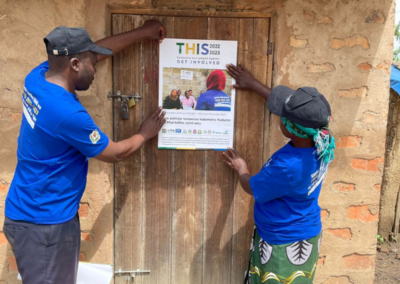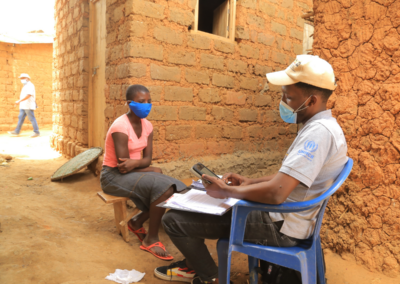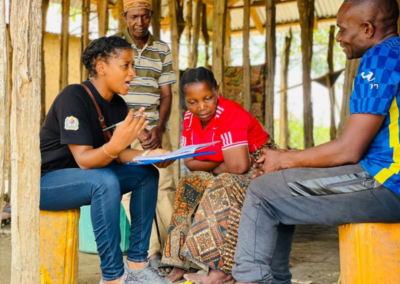About
What is the PHIA Project?
Since 2014, the Population-based HIV Impact Assessment (PHIA) Project has conducted nationally representative surveys to capture the state of the HIV epidemic in the most-affected countries. This effort is led by the Ministry of Health in each participating country and funded by the U.S. President’s Emergency Plan for AIDS Relief (PEPFAR) through the U.S. Centers for Disease Control and Prevention (CDC) with technical support from ICAP at Columbia University. The PHIA Project embraces strong and effective partnerships to change the course of the HIV epidemic.
The PHIA Project consists of cross-sectional, HIV-focused household surveys to assess the current status and effectiveness of national programs in reaching HIV epidemic control. Each survey offers participants household-based HIV counseling and testing with immediate return of HIV test results conducted by trained survey staff, with subsequent return of additional HIV related test results. The surveys also ask questions about access to preventive care and treatment services for adolescents and adults (15+) and children (if applicable). Survey results released to date measured national and regional progress toward UNAIDS’ 90-90-90 and 95-95-95 targets and guide HIV policy and funding priorities as countries strive for epidemic control.
ICAP provides technical assistance at the national level to strengthen data collection systems, enhance laboratory infrastructure, and build capacity to design, conduct, and analyze PHIAs in survey countries. The PHIA Project builds on ICAP’s expertise in data collection and management and lab-based measurement of HIV.
Learn how PHIA teams do their work and hear from leading experts on why PHIA data matters in this short video.
Methodology
The PHIA Project consists of HIV-focused, cross-sectional, household-based, nationally representative surveys of adults and adolescents aged 15 years and older. Some surveys also included children aged 0-14 years. To date, PHIA surveys have been completed in 15 countries with the release of key findings.
For the latest updates on data collection status and release of survey results, please visit the Timeline page.
Participation in PHIA surveys is voluntary and data collection consists of household interviews, individual interviews, and laboratory testing. Questionnaire data are collected by trained survey staff via computer-assisted personal interviews (CAPI), using Android-based tablet computers.
Interviews are conducted in pre-selected households, where eligible participants first provide informed consent and then answer questions regarding household membership and characteristics, individual sociodemographic characteristics, and HIV-related risk factors. Blood is collected by trained survey staff from consenting participants, followed by home-based HIV testing and counseling. Individuals who test positive for HIV are referred to care and treatment.
All blood samples are transported to laboratory facilities for processing, aliquoting and freezing within 24 hours, as well as subsequent quality control testing. Samples from HIV-positive individuals undergo additional testing, including quantitative assessment of viral load, qualitative presence of antiretroviral medications, and HIV subtyping and drug resistance testing.
Some PHIA surveys have also included diagnostic testing for other conditions such as syphilis, hepatitis B, and hepatitis C. More country-specific details can be found in the Resources section.
Frequently Asked Questions
What are the PHIA surveys and why are they being conducted?
The Population-based HIV Impact Assessment (PHIA) surveys are large, nationally representative household-based surveys that provide home-based HIV testing and counseling with immediate return of results. The surveys also:
- Collect socio-demographic, clinical and behavioral information;
- Collect data on access to and uptake of HIV treatment and prevention services;
- Estimate the percent (prevalence) and number of people living with HIV and the rate (incidence) and number of new annual HIV infections;
- Among HIV-positive individuals, test for CD4 cell counts, quantification of HIV viral load, presence of antiretroviral drugs and HIV resistance.
All information is recorded on tablets by trained survey staff and is treated as strictly confidential.
The goal of the PHIA surveys is to provide a population-level understanding of the status of HIV epidemic control at the national and sub-national level in participating countries, and to document the achievements of HIV programs in these countries. PHIA surveys provide stakeholders with the information they need to:
- Measure progress toward the Joint United Nations Programme on HIV/AIDS’ 95-95-95 targets;
- Measure HIV incidence, HIV prevalence, and viral load suppression among people living with HIV;
- Assess the effectiveness of country’s HIV prevention and treatment programs.
By collecting this information, the PHIA surveys help governments understand how effective their HIV programs are and where future efforts to control the epidemic should be focused.
Which organizations are carrying out the surveys and where?
The surveys are conducted through national ministries of health and other local partners. ICAP provides implementation and technical support for the surveys. The project is funded by the U.S. President’s Emergency Plan for AIDS Relief (PEPFAR) through the U.S. Centers for Disease Control and Prevention (CDC).
For more information on where the surveys are taking place, visit the Countries page.
The University of Maryland’s Center for International Health, Education and Biosecurity (CIHEB) has also collaborated in the implementation of PHIA surveys.
How are communities mobilized to participate in the survey?
To address community inquiries and generate survey support, each PHIA survey team adapts a community mobilization strategy specific to their local and cultural contexts through acquiring community acceptance, developing educational materials in local languages, and recruiting community members to be part of the survey team. Getting buy-in for the survey from all community, district, and national leaders is critical to enter communities with appropriate permissions. Community mobilization team members are recruited from the areas the survey will be conducted as they are familiar with the local language, customs, and community members.
Various community mobilization approaches are utilized community mobilization including door-to-door visits, group meetings, radio jingles, mass and community media outreach, edutainment (e.g. roadshows involving musicians and drama artists performing to the crowds), and the use of public address systems.
Familiarity with communities by local mobilizers, coupled with regular engagement and communication, enables a receptive environment for data collectors to visit selected households to conduct the survey.
Which results are returned at the household level and which are returned to clinics?
The result of the HIV rapid test conducted during the household survey, which is based on the national HIV testing algorithm, is provided to each participant at the household during posttest counseling.
CD4 testing is performed either at a satellite lab and returned to the clinic of the participant’s choice. In previous surveys, CD4 tests were conducted in households. HIV-positive participants are counseled to seek care at a care and treatment facility using an HIV referral form provided by the PHIA teams, particularly if they report that they are not already in HIV care or not already on antiretroviral therapy. Antiretroviral tests and HIV drug resistance testing are returned at a care and treatment facility. In later surveys, facilitated linkage to care processes have been implemented.
Additional centrally performed laboratory tests include HIV limited antigen avidity testing as part of an algorithm to document recent infection (incidence), HIV genotyping, drug resistance testing, and testing to detect the presence of ARVs in the blood. All clinically actionable results are returned to clinics.
In PHIA surveys, viral load results are returned for every HIV-positive participant across age groups. Blood samples from HIV-positive participants are tested for viral load at a central laboratory.
In previous PHIA surveys, which included children 0-14 years, children under 18 months with a positive rapid test result underwent Early Infant Diagnosis confirmatory testing. Both viral load and Early Infant Diagnosis results were returned to the care and treatment facility chosen by the participant. PHIA teams would go directly to the households to deliver positive Early Infant Diagnosis results.
What if a participant does not want to receive his or her HIV test result?
Participants are asked to consent to an individual questionnaire, followed by a request to consent to HIV testing, including return of results through home-based HIV testing and counseling. Only participants who consent to testing and receiving results are included in the biomarker collection.
How do Demographic and Health Surveys (DHS) and PHIA surveys differ?
The DHS and PHIA surveys are both population-based surveys. However, there are key differences between these two types of surveys:
The main purpose of the DHS is to provide data to monitor and evaluate population overall health, and nutrition programs. In general, the DHS covers household and respondent characteristics, and questions that address:
- Fertility and family planning
- Infant and child health and mortality
- Maternal health and maternal and adult mortality
- Child and adult nutrition
- Malaria
- HIV
- Domestic violence
- Orphans and vulnerable children
Many DHS surveys do measure HIV prevalence but historically have not returned results in the household. DHS, unlike some PHIA surveys, generally do not include children, may limit the adult age range differently, and may include only a subsample of adult males.
The main purpose of the PHIA surveys is to estimate HIV incidence and prevalence, the prevalence of viral load suppression, and measure progress toward achievement of the UNAIDS 90-90-90 targets. PHIA surveys include data on the uptake of care, treatment and prevention services for HIV and other infectious diseases; measure CD4 T-cell counts; and provide real-time Home-based HIV testing and counseling.
Another important difference between the DHS and PHIA surveys is the HIV testing method:
- The DHS approach generally uses anonymous dried blood spot testing with samples collected via finger prick whereas PHIA collects samples through venipuncture or finger/heel stick.
Previously, some DHS surveys relied on enzyme-linked immunosorbent assay (ELISA) testing without a confirmatory test. ELISA tests may identify someone as HIV positive who is truly HIV-negative. If not followed by a confirmatory test, the ELISA may result in an overestimate of HIV prevalence. Therefore, pre-2015 DHS estimates may be inaccurately elevated compared to a country’s true prevalence.
How do the PHIA surveys measure HIV prevalence?
PHIA surveys use a home-based testing and counseling (HBTC) approach to measure HIV prevalence, specifically:
- Whole blood samples from venipuncture among adults and children over two years* or from finger/heel stick for children under two years* or adults who refuse or failed to provide venipuncture samples are collected in the home;
- Blood samples are tested in the household using the national rapid HIV test algorithm
- All samples classified as HIV positive based on the national algorithm are retested with a supplemental test to confirm the results;
- For quality control, the first 25 HIV testing samples collected by nurse interviewers who performed the tests in in the households are re-tested in a satellite laboratory using the national HIV rapid testing algorithm.
For more information, visit the Methodology section on this page.
*Note: PHIA surveys in 2019-2020 do not include children
How do the PHIA surveys measure HIV incidence?
Estimation of HIV incidence in PHIA surveys is based on the classification of confirmed HIV-positive cases as recent or long-term HIV infections.
A laboratory-based recency determination algorithm (HIV-1 limiting antigen (LAg) avidity + viral load (VL) + antiretroviral (ARV) detection) is used to distinguish recent from long-term infections.
Incidence estimates were obtained according to the formula recommended by the World Health Organization’s Incidence Working Group and Consortium for Evaluation and Performance of Incidence Assays using the following assay performance characteristics: mean duration of recent infection =130 days (95% CI: 118, 142), time cutoff=1.0 year and residual proportion false recent=0.00. Survey weights were utilized for all estimates.
Prior to the current approach, the laboratory-based recency determination algorithm used in the first few years of the PHIA included included the HIV-1 LAg avidity and VL detection.
Are HIV incidence estimates available for smaller age bands and zones?
The PHIA sample size in each country is designed to estimate national HIV incidence with a reasonable degree of precision among adults. As the number of recent infections is relatively low, further disaggregation by age, sex, or subnational area results in imprecise estimates with very wide confidence intervals. Generally, it is therefore not possible to make meaningful comparisons across these disaggregated estimates.
Has survey participation among men differed from among women?
Across various demographic surveys, participation among men has generally lagged behind women. In several PHIA surveys, it was necessary to visit the households several times to find men at the household. Men have more often been away from their homes for reasons such as daily work, migrant work or due to taking part in social gatherings.
The PHIA survey teams employ various strategies to try to reach men, such as:
- Tailoring messages to mobilize men to participate in the survey
- Engaging male community leaders and peer educators to assist in mobilization
- Visiting households earlier in the morning or later in the evening, when men are more likely to be home
- Offering the survey at a location of their choice (not necessarily at the household)
In terms of results, PHIA survey data are weighted to account for nonresponse to the household interview, individual interview, and HIV testing. For household interview nonresponse, the weights of responding households are increased to account for any nonresponding households within each enumeration area.
For individual interview and HIV testing nonresponse, a CHAID (CHi-squared Automatic Interaction Detector) algorithm is employed to adjust the weights of responding individuals to account for any nonresponding individuals, based on characteristics of participants and nonparticipants.
Finally, PHIA survey data are also weighted to account for noncoverage, which may arise due to incomplete enumeration of households or household members. This procedure involves calibrating nonresponse-adjusted weights so that the sum of the weights conforms to population totals from current population projection data.
What are the UNAIDS 95-95-95 targets and how are PHIA results used to calculate these targets?
The Joint United Nations Programme on HIV/AIDS targets for HIV epidemic control are that by 2025, 95% of all people living with HIV will know their status; 95% of all people with diagnosed HIV infection will receive sustained antiretroviral therapy; and 95% of all people receiving antiretroviral therapy will achieve viral load suppression. These targets build upon the previous 90-90-90 targets set for 2020.
The PHIA surveys ask participants to report their HIV status (if they already know they are HIV positive, or if they were HIV negative when last tested, or if they don’t know their status) and then if they report that they are aware that they are positive, whether they are receiving antiretroviral therapy.
For those who consent to biomarker collection and test HIV positive, a viral load test is conducted, and individuals are classified as having a suppressed viral load (<1000 copies/mL) or not having a suppressed viral load (>1000 copies/mL).
The 95-95-95 targets for PHIA surveys are estimated as follows:
- First 95: Of survey participants who tested HIV positive, what percentage reported prior knowledge of their HIV-positive status?
- Second 95: Of those who reported knowing their HIV-positive status, what percentage reported being on ART?
- Third 95: Of those who reported being on ART, what percentage had suppressed viral load?
Not all people who know they are HIV-positive report it to an interviewer. For this reason, PHIA complements the self-reported information with antiretroviral testing in the blood. If someone who tests HIV-positive in the survey reports not having prior knowledge that they were positive but also has antiretrovirals detected in the blood, they are added to the category of those who had prior knowledge. Similarly, not all HIV-positive individuals accurately report being on antiretroviral therapy. As such, if a person living with HIV reports not being on antiretroviral therapy but has antiretrovirals detected in the laboratory analysis, they are added to the category of those who are on ART.
What is the interpretation of confidence intervals for HIV prevalence measures?
Confidence Intervals: The 95% CI (confidence intervals) indicates that the interval within which the true population parameter is expected to fall 95% of the time for a given estimate. Even if the HIV prevalence point estimates differ between surveys, the estimates should be viewed considering their confidence intervals. If intervals overlap, then any difference between the point estimates is not necessarily meaningful and could be due simply to chance.
What is the interpretation of sample size for HIV incidence, prevalence, and viral load suppression measures?
Sample size: Generally, the sample size is designed to provide subnational-level (e.g., provinces, regions) estimates of viral load suppression among HIV-positive people aged 15 to 49 years with a 95% CI +/- 10% or less. This sample size requirement typically yields a reasonably precise estimate of national-level annual HIV incidence among people aged 15 to 49 years. Precision criteria are used to obtain an estimate of the number of households that need to be approached and take into account adjustments for household vacancy and non-response, number of individuals per household, individual non-response, and refusal of blood testing or specimen loss.
How are the PHIA survey results shared with in-country stakeholders?
The PHIA survey results are shared through two resources: the summary sheet and final report. The summary sheet provides the key survey findings in a short, abbreviated format. The final report is more detailed, providing information on how the survey was conducted, the survey methodology, and in-depth analysis of survey results illustrated through figures, graphs, and tables.
In-country stakeholders are involved with the summary sheet and final report development. When each report is finalized, a national dissemination meeting or event typically takes place. This event involves participation from all key survey partners as well as from media partners who are invited to share the survey results with the national public.
Survey results are also shared during global public health meetings, conferences, and events such as the International AIDS Conference, World AIDS Day, and more.
When will the PHIA results be released?
See the Timeline page for updated information on when results have been or will be released for each survey.
Who can use data generated from PHIA surveys?
Results of the PHIA Project are made available broadly and can be found on the Data and Resources section of the PHIA website. This includes access to summary sheets, final reports, a data visualization site, and downloadable data sets.
PHIA data provide a valuable resource for policymakers, program managers, funders, researchers, among others. The data are used to inform national and global HIV policies, strategies and funding. The information also helps guide program planning to focus on the most effective interventions and identify the geographic areas and populations most in need of services.
For more information, visit the Data and Resources section of the PHIA website.
Recent PHIA News









